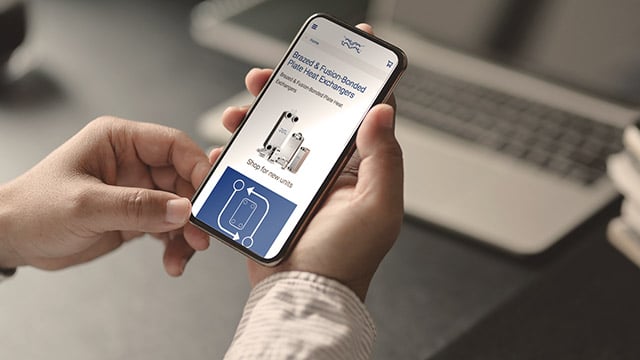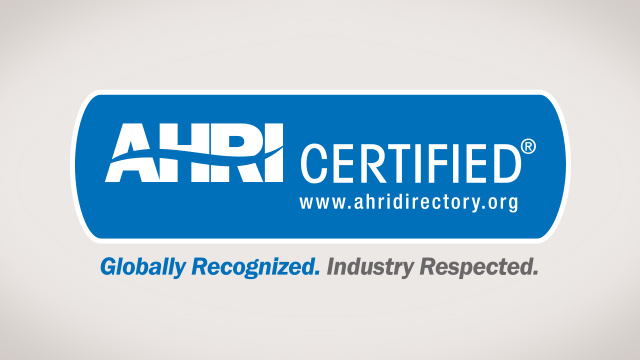Isıtma ve Soğutma SSS
Alfa Laval uzmanlarının yanıtlarıyla birlikte sık sorulan soruları aşağıda bulabilirsiniz. Aradığınız soru burada değil mi? Deneyimli ekibimizden kişisel bir yanıt almak için bizimle iletişime geçebilirsiniz.
Lehimli ve füzyon-bağlı plakalı eşanjörlerle ilgili sorular
Contalı plakalı eşanjörlerle ilgili sorular
Yarı kaynaklı plakalı eşanjörler ilgili sorular
Genel sorular
Bir ısı eşanjörünün boyutunu ne belirler?
Genel ısıtma uygulamaları için, ısı eşanjörünün boyutunu belirleyen kW değil, izin verilen basınç düşüşüdür. Bunun nedeni uygulamaların düşük NTU olmasıdır. Boyutu belirleyen diğer faktörler, yaklaşma sıcaklığını ve ısı eşanjörü için seçilen plaka malzemesini içerir.
Alfa Laval, buharlı ısıtma uygulamaları için ne tür ürünler sunabilir?
Alfa Laval'in buharlı ısıtma uygulamalarına uygun birçok ürünü vardır, ancak tercih edilen tipler derin presleme derinliğine sahip contalı ünitelerdir. Düşük teta plakalı TS ve M-tipleri bu uygulamalar için en uygunudur.
Son derece kompakt oldukları için lehimli ve füzyon bağlı ısı eşanjörleri de kullanılabilir. Bununla birlikte, bu modeller termal yorgunluğa daha duyarlı olabilir. Bu nedenle, büyük, ani ve sık sıcaklık değişimlerine maruz kaldıkları uygulamalarda bu tür ünitelerden kaçınılmalıdır.
Uygulamam için doğru boya standardını nasıl seçerim ve Alfa Laval ne tür boya sistemleri sunar?
Ürünlerimizi estetik sebeplerle boyarken asıl amacımız korozyona karşı korumadır. Üniteyi korozyondan korumak için doğru boya sistemini seçmek çok önemlidir.
Bir boya sistemi seçerken göz önünde bulundurulması gereken birçok husus vardır. Ünitenin hizmette olacağı mevcut çevresel koşullar özellikle önemlidir. Belirli bir korozyon sınıfı var mı? Ünite iç mekana mı yoksa dış mekana mı yerleştirilecek? Herhangi bir ciddi kirliliğe maruz kalacak mı? Asit veya alkali sıçrama olasılığı var mı? Açık deniz/deniz/kıyı ortamı için mi olacak? Ünite yalıtımlı mı yoksa yalıtımsız mı olacak? Sürekli yoğuşma riski var mı, yok mu? Tüm bu parametreler farklı boya sistemleri gerektirir.
Alfa Laval, C2, C3 ve C5 farklı korozyon kategorilerine ayrılmış 14 farklı boya sistemine sahiptir. Bunlardan bazıları özel uygulamalar içindir. Destek almak için Alfa Laval merkez ofisi ile iletişime geçebilirsiniz.
Isı pompaları için kondansatör olarak kullanılan ısı eşanjörlerinde asimetri neden bu kadar önemlidir?
Soğutucu akışkan tarafındaki dar kanallar, kısmi yükte bile ısı alışverişini artırarak daha yüksek iç hıza izin verir. Aynı zamanda, su tarafındaki daha büyük kanallar ünite boyunca basınç düşüşünü azaltır. Birlikte, bu, ısı pompasının performans katsayısı üzerinde olumlu bir etkiye sahiptir ve tüm sistem için performansı artırır.
Lehimli ve füzyon-bağlı plakalı ısı eşanjörleri hakkında sorular
Lehimli ve füzyon bağlı ısı eşanjörlerinde su tarafı filtresi neden bu kadar önemlidir?
Su devresinde sirkülasyonda çok sayıda küçük parça ve döküntü vardır. Bunların çoğu, ünitenin küçük kanallarında tutulabilen kaynak artıklarıdır. Bu, daha yüksek basınç düşüşünden plakalar arasında düzensiz sıvı dağılımına ve hatta devreler arasında sızıntıya yol açan korozyona kadar bir dizi soruna neden olabilir.
Evaporatör olarak kullanılan lehimli ısı eşanjörlerinde soğutucu akışkan basınç düşüşü neden özellikle yüksek olabilir?
Lehimli ısı eşanjörleri, hatta daha uzun veya daha uzun modeller, soğutucu akışkanı tüm kanallara dağıtan bir dahili dağıtım sistemi ile çalışır. Bu dağıtıcılar, genellikle küçük geçitler ve bölmeler içeren özel bir geometriye sahip olmalıdır. Bu da birçok durumda basınç düşüşüne neden olabilir. Bununla birlikte, genleşme vanası buna göre (çoğu durumda biraz daha büyük) tasarlandığı sürece bu kendi başına bir sorun değildir.
AlfaNova füzyon bağlı ısı eşanjörleri neden lehimli eşanjörlere göre korozyona daha dirençlidir?
AlfaNova ısı eşanjörleri bakır içermez; %100 kalite 316 paslanmaz çelikten yapılmıştır. Lehimli tasarımlarda bakır, paslanmaz çelik kanal plakalarını bir arada tutan malzemedir. Ne yazık ki bakır, soğutucu olarak amonyağın kullanıldığı veya örneğin daha yüksek klorür içeriği nedeniyle agresif suyun olduğu uygulamalar gibi belirli korozyon türlerine karşı daha az dirençlidir. Bu uygulamalarda %100 bakır içermeyen AlfaNova modeli bu nedenle tavsiye edilir.
2 fazlı evaporatörler için soğutucu giriş bağlantısı neden bu kadar önemlidir?
S3 soğutucu akışkan giriş bağlantısı, bakır boruların lehimlenmesi için bir konektörden daha fazlasıdır. Bu bir ön dağıtıcıdır ve geometrisi ünite boyunca soğutucu akışkanın dağıtımını etkiler. S3 bağlantısının iç çapı, akışkanın hızını ve türbülansını etkiler, böylece soğutucu akışkan her bir kanalda eşit olarak dağıtılır. Bir ünitedeki her ilave plaka ile S3 geometrisi giderek daha önemli hale gelir. Alfa Laval'ın evaporatörleri, soğutucu akışkan, plaka sayısı ve uygulamaya bağlı olarak en iyi performansı elde etmek için özel bağlantılarla optimize edilmiştir.
Aynı lehimli veya füzyon bağlı ısı eşanjörü hem kondenser hem de evaporatör olarak kullanılabilir mi?
Evet. Bu mümkündür ve birçok farklı uygulamada yapılmıştır. Evaporatörlerin dağıtım sistemi, kondansatör olarak kullanıldığında performansı tehlikeye atmaz ve ek basınç düşüşü genellikle ihmal edilebilir düzeydedir. Bununla birlikte, kısmi bir yoğuşma sorunlara yol açabileceğinden, yoğuşmanın yoğuşturucu çıkışında aşırı soğutulmuş sıvıyla dolu olması gerekir. Tersinir sistemlerde, evaporatör olarak da iyi performans sağlamak için kondenserin bir dağıtım sistemine sahip olması tavsiye edilir.
Evaporatörlerde yağ dönüşünü nasıl sağlarım?
Alfa Laval evaporatörlerde hem dağıtım sisteminin hem de kanal plakalarının tasarımı yağın kompresöre geri dönüşünü sağlar. Soğutucu akışkan miktarı ve hızı çalışma sırasında büyük ölçüde değişebileceğinden, bu durum özellikle inverter tahrikli kompresörlerle ilgilidir. Güvenli çalışmayı sağlamak için evaporatörün minimum yükte performansını doğrulayan yazılım zorunludur.
2 fazlı uygulamalarda aynı lehimli veya füzyon bağlı ısı eşanjörü farklı soğutucu akışkanlarla kullanılabilir mi?
Evet. Alfa Laval ısı eşanjörleri birçok farklı soğutucu ile kullanılabilir. İlk tasarım aşamasında, bir ısı eşanjörü bir veya iki ana soğutucu akışkan için optimize edilebilir. Alfa Laval'ın en son teknolojisi, hem inverter tahrikli kompresörler (çalışma sırasında yüksek kapasite değişimleri ile) hem de çevresel nedenlerle pazara giren artan sayıda yeni soğutucu akışkan için oldukça esnektir. Yenilikçi dağıtım sistemleri ve yeni kanal plaka tasarımı sayesinde bu esneklik, ünitelerin birçok farklı soğutucu akışkan ile yüksek performansta kullanılmasına olanak tanır.
Isı pompalarında donma söz konusu olduğunda nelere dikkat edilmelidir?
Donma, ısı pompası operasyonunda dikkate alınması gereken ana konulardan biridir. Alfa Laval ısı eşanjörleri, havadan suya ısı pompalarında defrost sırasında donmayı önlemek için özel olarak tasarlanmıştır. Bununla birlikte, donmanın önlenmesi, özellikle kompresör kapasitesi, tuzlu su akışı ve sıcaklıklar açısından sistem için belirlediğiniz çalışma koşullarına bağlıdır.
Alfa Laval, hem laboratuvarda hem de yazılım aracılığıyla düzenli olarak simülasyonlar gerçekleştirir ve bu, güvenli çalışma sınırlarını belirlemenize yardımcı olabilir.
Belirli bir lehimli veya füzyon bağlı ısı eşanjörü için izin verilen maksimum ve minimum kapasiteler nelerdir?
Maksimum ve minimum kapasiteler, kabul edilebilir performans seviyelerine göre belirlenir. Kapasite arttıkça, ünite daha düşük buharlaşma sıcaklığı, 2 fazlı uygulamalarda daha yüksek yoğuşma sıcaklığı, 1 fazlı uygulamalarda daha yüksek sıcaklık farkı ve su veya tuzlu su basıncı düşüşü yaşayabilir. Bütün bunlar sistemin genel performansını düşürür. Tersine, mümkün olan en düşük kapasite, kompresöre yağ dönüşü ve kanallara düşen hız nedeniyle ilgili olası düşüş ile sınırlıdır.
Questions about gasketed plate heat exchangers
What is the minimum temperature difference you can have between the two sides of a gasketed plate heat exchanger?
Customers today are focused on saving more energy, and the trend in heat recovery duties is for minimal additional cooling/heating to recover more energy. That means that the units will work with a smaller temperature difference.
For liquid/liquid duties, Alfa Laval offers plate heat exchangers that can work down to a temperature difference of about 1°C. Compare this to shell-and-tubes, where the limit is around 5°C. The reason why we can work with such a low temperature difference is that our units have an arrangement that is almost counter-current.
What is the maximum temperature difference you can have between the two sides of a gasketed plate heat exchanger?
If looking at liquid/liquid duties from a thermal point of view, there is no maximum limit. If you have very high temperature differences, which also includes very high temperatures, you should take into consideration the radiation effect. However, since Alfa Laval has a maximum design temperature of around 180°C for gasketed plate heat exchangers, this is not an issue.
When you have a large temperature difference, it can be a large temperature difference between the bulk temperature and the wall temperature. You should check the wall temperature to avoid boiling or freezing as well as excessive fouling.
What gasket material should I use?
Depending on the media, different gasket materials are more or less suitable. In HVAC applications where the media tends to be water/water, the recommended gasket material is NBR, which is available in several different qualities.
What is the gasket lifetime?
Gasket lifetime depends on many different factors, most importantly the operating temperature and pressure, and the media in question. However, the lifetime is also determined by the cleaning agents used, how often the plate heat exchanger has been opened and closed, if the heat exchanger is used in continuous operation or not, and how the gaskets have been stored.
If the plate heat exchanger is running at the maximum recommended temperature, the gasket lifetime is one year. The lifetime will be longer at a lower temperature, but all of the factors listed above must be considered in order to reach a rough lifetime prediction.
How do I know which type of gasket I have in my heat exchanger?
There are three ways to identify the gaskets. Start by finding the documentation that was supplied with the unit at the time of purchase. Next, look for a tag on the gasket with the article number, which you can find on our new T-range. If your gaskets do not have this tag, you can look for a colour code, which is typically located on the clip of the gasket. In some cases, the colour code is on the inside of the gasket, and this can sometimes even be seen from the outside. Contact Alfa Laval with this information and the information located on your unit’s name plate, and our representatives can help you determine your model and gasket type.
Questions about semi-welded plate heat exchangers
When shall I use a brazed, fusion-bonded or semi-welded plate heat exchanger in a refrigeration application?
A SWPHE is preferably used with high capacity duty, when the heat exchanger needs to be easily opened for maintenance (for instance in cases with dirty cooling water) or when using corrosive medias like saltwater or chloride brines requiring use of titanium or other corrosion resistant material.
Fusion-bonded plate heat exchanger is the best choice for any small or intermediate size duty requiring a copper free heat exchanger, for instance any ammonia application.
Brazed plate heat exchanger offers a tailor-made performance in any small or intermediate size refrigeration application where copper and stainless-steel components can be used, with design pressures up to 140 bar.
What is the minimum temperature difference you can have between the brine/water side and the evaporation temperature in a SWPHE flooded evaporator?
We normally say that an approach could be minimum 2K, if the liquid separator is mounted above the unit. Then the liquid column will be more or less optimal (c/c + 0.5 m) and the pressure losses be reasonable. A good oil separation system will also improve the possibilities to achieve a close approach. Please ask your Alfa Laval representative for an advice if you are in doubt.
What is the largest temperature difference I can have between the inlet and outlet brine/water in a SWPHE evaporator?
To give a general answer we normally say 15K. The reason is that if we have a higher Δt we will have a low pressure drop in the channels. That means a lower turbulence in the channels which will reduce the heat transfer efficiency and make the self-cleaning effect lower. A clean heat transfer area is always important for the performance.
Using a multi-pass heat exchanger will increase the heat transfer length of the SWPHE and allow for a higher temperature difference.
Can I use any type of media in a SWPHE?
No, you should always ask the Alfa Laval representative if you are going to use an unknown fluid. That can e.g. be a brine type on the brine/water side or a compressor oil on the refrigerant side. If you are in doubt your Alfa Laval representative will be able to advice both in metal and in gasket material selection.
A SWPHE allows for use of a wide range of heat transfer plate material such as titanium and SMO (ALLOY254) enabling use of corrosive material such as sea water or chloride-based brines.
What level of design pressure shall I select for a SWPHE?
First, you must check what your locally used pressure vessel code is saying. We generally say that the minimum design pressure should be the operating pressure times 1.3. If you use this factor you can assure the high-pressure safety switch-off device will work properly. It is then allowed to have some small pressure variations in the refrigeration system without a lot of false alarms and unwanted shut offs. Alfa Laval offers SWPHE with design pressures up to 63 bar (900 psi).
Why is the refrigerant side pressure drop so important in a SWPHE thermosiphon evaporator?
As the system is only using the natural laws, with help from the gravity, the density and the height of a liquid column, every pressure drop will affect the performance. An increased pressure drop can always be converted to a higher compressor load and therefore a higher need of input power. It will always cost more to be imprudent with the pressure drop on the refrigeration side compared to the water side. The energy needed in the compressor motor is always much higher compared to the need in the circulating pump motor.
Why is it important to drain oil in a refrigeration system with a SWPHE evaporator?
Compressor oil contamination is common in refrigeration systems. In industrial ammonia refrigeration, using non soluble oil, it is expected that this oil will gather in the coldest place in the system; the evaporator. In the evaporator the oil will build up a film on the heat transfer surfaces, effectively creating a fouling which reduces the evaporator performance.
In order to reduce the oil fouling, Alfa Laval recommends any user of a non-soluble oil to install an efficient oil separation before the refrigerant enters the evaporator.
How often do I need to change the gaskets in a SWPHE?
The time between service of any gasket plate heat exchanger or SWPHE is dependent on the duty. A unit running with sea or river water might need cleaning of the heat transfer surface more often than a heat exchanger running with a closed loop brine circuit.
For a normal closed loop glycol circuit evaporator or a CO2/ammonia cascade condenser normal time between gasket changes will be 15 years or more. Please contact your local Alfa Laval representative for advice.
Why is the heat transfer area so small in a SWPHE compare to a shell-and-plate or shell-and-tube type of heat exchanger?
The plates of a SWPHE are designed to always maintain a turbulence flow in the channels.
The turbulent flow secures a very high efficient heat transfer which drastically reduces the amount of heat transfer area needed compared to other technologies.
Alfa Laval SWPHEs are optimized for use in refrigeration applications and use flow equalization, for instance CurveFlow™, to make sure that all the heat transfer surface is used which results in high efficiency operations also in part load.
Which gasket type shall I use in a SWPHE for a refrigeration application?
The gasket type to use will depend on the media/refrigerants used and the operating temperature. It is also common that the refrigerant contains traces of compressor oil in which case the gasket material also must be compatible with this media.
In an industrial refrigeration application, it is common to use NBRLT (Low temperature nitrile) material for low temperature applications. For intermediate temperature CR (Chloroprene) is used for the ring gasket in combination with NBR (Nitrile) field gasket while HNBR (High temperature Nitrile) and FEPMAL is used for ring gaskets in condensers and high temperature applications.
Questions about AHRI performance certification
Is it mandatory to use an ASME pressure vessel code when specifying AHRI-certified plate heat exchangers?
No. Any pressure vessel code can be used. The certification is about thermal performance only and has nothing to do with mechanical performance and quality in general.
Is the AHRI LLHE certification program only valid in North America?
No. Customers are free to specify AHRI LLHE certification anywhere in the world. In North America, however, members of the certification program must offer certified models to customers if the duty is within the scope of the program, regardless of if AHRI certification has been specified in the bidding documents.
How can customers receive verification that the manufacturer has sized the plate heat exchanger in accordance with the AHRI LLHE certification program?
This is very simple. Customers can send the manufacturer’s specification sheet to AHRI and the AHRI staff will then verify the sizing – free of charge!
Is it complicated to specify AHRI-certified plate heat exchangers?
Not at all! Just add one sentence in your bidding document in which you specify the heat duty: “The plate heat exchanger shall be certified in accordance with the AHRI LLHE Certification Program.”
Can the AHRI Certification Program be used in industries other than HVAC?
Yes. Customers in any industry may use the AHRI LLHE certification Program for any duty covered by the scope of the certification program.
Alfa Laval Ürün Kataloğu
Alfa Laval uygulamanız için en iyi çözümü bulmanızı kolaylaştırır. Ürünlerimize göz atmak ve teklif alabileceğiniz Alfa Laval iş ortaklarını bulmak için ürün kataloğumuza göz atın.

Looking for more tools and expertise?
Get more of the knowledge Alfa Laval has gained in our 8+ decades of experience in thermal transfer. From BIM files, 3D drawing, consultant tools and much more, take a look at the many other resources we offer in the Alfa Laval HVAC Consultant Portal.

AHRI performans sertifikalı ısı eşanjörleri
Havalandırma, Isıtma ve Soğutma Enstitüsü'nün (AHRI) sertifikası, termal performansın global olarak tek tarafsız doğrulamasıdır ve size plakalı ısı eşanjörünüzün üreticinin yayınladığı derecelendirmelere uygun olarak çalışacağına dair bağımsız bir güvence verir. Alfa Laval, AHRI sertifikalı contalı plakalı ısı eşanjörleri, lehimli plakalı ısı eşanjörleri ve füzyon-bağlı plakalı ısı eşanjörleri tedarikçisidir.

